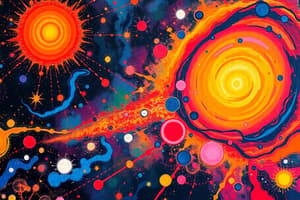Podcast
Questions and Answers
What is the process called that creates new atomic nuclei from pre-existing nucleons?
What is the process called that creates new atomic nuclei from pre-existing nucleons?
- Nucleosynthesis (correct)
- Big bang nucleosynthesis
- Nuclear fission
- Stellar evolution
Which of the following isotopes were produced during Big Bang nucleosynthesis?
Which of the following isotopes were produced during Big Bang nucleosynthesis?
- C-12
- Fe-56
- H-1, H-2, He-3, He-4, and Li-7 (correct)
- He-6
What is the primary difference between nucleosynthesis and stellar nucleosynthesis?
What is the primary difference between nucleosynthesis and stellar nucleosynthesis?
- There is no difference between nucleosynthesis and stellar nucleosynthesis.
- Nucleosynthesis is the process of creating new atomic nuclei from pre-existing nucleons, while stellar nucleosynthesis is the process of creating new atomic nuclei by the fusion of lighter nuclei in the interior of stars. (correct)
- Nucleosynthesis is the process of creating new atomic nuclei by the fusion of lighter nuclei in the interior of stars, while stellar nucleosynthesis is the process of creating new atomic nuclei from pre-existing nucleons.
- Nucleosynthesis occurs only in stars, while stellar nucleosynthesis occurs in the early universe.
What is the name of the process by which light nuclei fuse together to form a heavier nucleus?
What is the name of the process by which light nuclei fuse together to form a heavier nucleus?
What is the primary difference between nuclear fusion and nuclear fission?
What is the primary difference between nuclear fusion and nuclear fission?
Which of the following elements is NOT formed during Big Bang nucleosynthesis?
Which of the following elements is NOT formed during Big Bang nucleosynthesis?
What is the main source of energy for stars?
What is the main source of energy for stars?
Which of the following is NOT a product of stellar nucleosynthesis?
Which of the following is NOT a product of stellar nucleosynthesis?
Flashcards
Big Bang Nucleosynthesis
Big Bang Nucleosynthesis
The formation of light elements shortly after the Big Bang.
Nucleosynthesis
Nucleosynthesis
The process of creating new atomic nuclei from nucleons.
Fusion
Fusion
The process where light nuclei combine to form a heavier nucleus.
Isotope
Isotope
Signup and view all the flashcards
Stellar Nucleosynthesis
Stellar Nucleosynthesis
Signup and view all the flashcards
Carbon-Nitrogen-Oxygen Cycle
Carbon-Nitrogen-Oxygen Cycle
Signup and view all the flashcards
Triple Alpha Process
Triple Alpha Process
Signup and view all the flashcards
Supernova
Supernova
Signup and view all the flashcards
Study Notes
Module 1: Formation of Elements in the Big Bang and Stellar Evolution
- Objectives:
- Explain and provide evidence for the formation of light elements in the Big Bang theory.
- Describe and provide evidence for the formation of heavier elements during star formation and evolution.
- Write the nuclear fusion reactions in stars that lead to the formation of new elements.
Big Bang Nucleosynthesis
- As the universe cooled and subatomic particles formed, it entered the phase of Big Bang nucleosynthesis.
- This process strongly favors very light isotopes of hydrogen and helium, due to their lower atomic mass compared to other elements.
Nucleosynthesis
- Nucleosynthesis is the process that creates new atomic nuclei from pre-existing nucleons, primarily protons and neutrons.
Big Bang Nucleosynthesis Details
- Proton + neutron = deuterium
- Deuterium + neutron = tritium
- Big bang nucleosynthesis strongly favors light isotopes like hydrogen (1.008) and helium (4.003).
Subatomic Particles
- Atom: The smallest unit of matter.
- Proton: Positively charged subatomic particle.
- Neutron: Subatomic particle with no charge.
- Electron: Negatively charged subatomic particle.
Nuclear Fusion
- Nuclear fusion is the process where light nuclei fuse together to form a heavier nucleus.
- Isotopes are forms of an element with the same atomic number but have different atomic masses or mass numbers.
- Fusion means combination or to fuse together
- Fission means separation or splitting of particles
Origin of Heavier Elements
- Elements heavier than iron form only billions of years after stars are created because the density within stars needs to be high enough to sustain fusion for a long enough time
- Stellar nucleosynthesis is the formation of heavy elements by fusion of lighter nuclei in the interior of stars.
Star Fusion Processes
- Stars are hot enough to burn hydrogen (1H) to helium (4He).
- There are multiple nuclear pathways to produce heavier elements including:
- Carbon-Nitrogen-oxygen cycle
- Proton-proton fusion
- Triple alpha process
- Layers near the star's core have tremendously high temperatures to nucleosynthesize heavy elements like silicon and iron.
Elements Heavier than Iron
- Elements heavier than iron are created in a supernova, a massive star explosion.
- Fusion processes for elements heavier than iron require tremendous amounts of energy.
- Neutron capture reaction in supernovae creates heavier elements by adding neutrons to existing nuclei.
Neutron Capture Reactions
- Adding neutrons to a nucleus doesn't change the element, but rather creates a more massive isotope.
- Elements higher than iron require tremendous energy to form.
Summary
- Three processes lead to the formation of elements: nucleosynthesis, fusion, and neutron capture.
- Energy from the continuously expanding universe forms these elements, which make up matter today.
- Nucleosynthesis formed light elements; fusion in stars formed elements with atomic masses in a certain range; neutron-capture reactions in supernovae created elements heavier than iron.
Studying That Suits You
Use AI to generate personalized quizzes and flashcards to suit your learning preferences.




